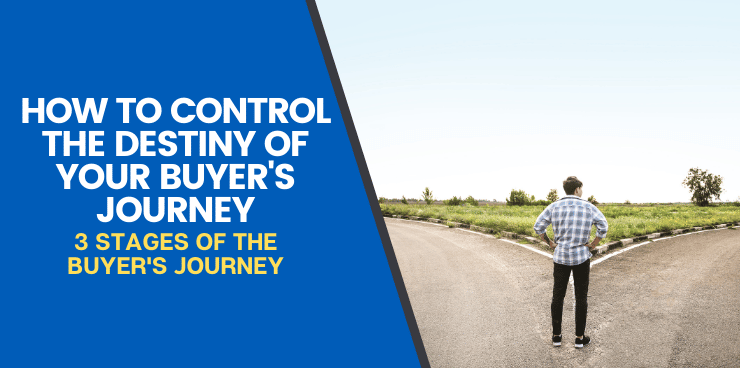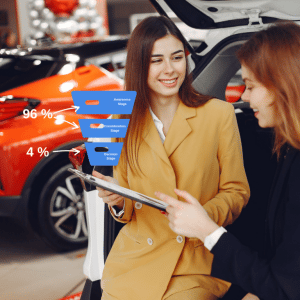
When it comes to making a purchase, customers today want to feel confident that they are getting the best bang for their buck.
This means doing their research and considering all of their options before committing to a product or service.
This increased competition can be intimidating, but it also presents you with more opportunities to reach buyers at different stages of the buyer journey.
Knowing which stage of the customer buying journey they’re in will help you better understand how to reach them and what messaging will be most effective.
For example, if you are targeting customers who are just starting to explore their options, you might want to focus on your product’s features and benefits.
Conversely, if you are targeting customers who are ready to buy, you might want to focus on your product’s value and how it compares to the competition.
No matter what stage of the buyer journey a customer is in, knowing your customers’ pain points, how to solve them and then convert them into sales will be the key to taking your business to the next level.
In this article, we’ll explore how to reach buyers at every stage of the buyer’s journey and what messaging will be most effective.
What Is the Buyer’s Journey?
The buyer’s journey is the process that buyers go through when they are considering buying a product or service.
The journey typically starts with the buyer becoming aware of a problem or need that they have and then researching possible solutions. After narrowing down their options, the buyer will decide which product or service to buy and then complete the purchase.
The buyer’s journey can be divided into three stages: awareness, consideration, and decision. In the awareness stage, the buyer becomes aware of a problem or need that they have. In the consideration stage, the buyer researches possible solutions and narrows down their options. And in the purchase stage, the buyer decides which product or service to buy and completes the purchase.
There are a variety of factors that can influence a buyer’s journey, including their age, gender, location, and occupation.

Why is it So Important to Know Your Customers’ Buyer’s Journey?
As a business owner, you know that it’s important to know your customers. And with the buyer journey, it is just as important.
The buyer journey is all about understanding your customer’s purchasing processes so that you can create content and marketing campaigns that speak to them directly.
By understanding the buyer’s journey stages, you can create a content strategy that will help you reach your target audience as well as convert leads into customers.
This is because it will make your marketing and sales processes more efficient, as you will be targeting leads that are already interested in your product or service.
When you can identify the different stages that a customer goes through before they buy from you, you can create content and messaging that is relevant and useful to them. This will help you establish trust and credibility, which can eventually lead to a sale.
The 3 Stages of the Buyer’s Journey (Customer Decision Process)
The buyer’s journey is a three-stage process that customers go through when making a purchase. Here, we’ll break down each stage and what it entails.
 1. Awareness
1. Awareness
The first stage is the awareness stage. During this stage, the buyer becomes aware of a problem or need that they have. They may start to do some research on potential solutions, but they aren’t ready to make a purchase yet.
This can look like a buyer coming across your brand or product for the first time, and becoming interested in learning more. They may start to follow you on social media, read your blog, or sign up for your email list.
The best way to reach buyers during the awareness stage is with content that helps them understand the problem they’re experiencing. This could be in the form of blog posts, infographics or even videos.
It’s important to provide helpful information without being too sales-y. You want to show potential customers that you understand their problem and that you can help them find a solution.
If you can capture the buyer’s attention during the awareness stage, you’ll be in a good position to convert them into customers later on.
2. Consideration
The second stage is the consideration stage. During this stage, the buyer is exploring their options and considering different products or services.
They might be researching your product or service online, asking for recommendations from friends or family, or visiting stores (online or offline) to get a feel for what’s available and compare you with competitors.
The most important thing during the consideration stage is to make sure your company is top of mind. You need to be visible and present where your buyer is looking, whether that’s through ads, search engine optimization or content marketing.
Make sure you’re providing helpful information and resources that will help buyers make a decision. Offer clear value propositions, highlight your unique selling points and answer any questions buyers might have.
The consideration stage is key to winning over buyers – make sure you put your best foot forward!
3. Decision
The third stage is the decision stage. This is when the buyer has gathered all of the information they need and must make a decision on which product or service to purchase.
This stage is considered the purchase journey, and can be broken down into three steps: narrowing down the options, making a decision and taking action.
- Narrowing down the options: The buyer will have a list of finalists, and they will need to figure out which one is the best fit for them.
- Making a decision: The buyer will weigh the pros and cons of each option and decide which one is best.
- Taking action: The buyer will purchase the product or service and use it.
To ensure that your buyer commits to a purchase, you need to provide them with the right messaging. This means emphasizing the benefits of your product or service and showing how it solves the buyer’s problem.
You can also highlight customer reviews and testimonials to build trust or offer a money-back guarantee to reduce risk. Whatever you do, make sure your message is clear and convincing so that the buyer feels confident in their decision.
 Key TakeAway
Key TakeAway
Understanding the buyer journey helps businesses create content and marketing strategies that appeal to buyers at different stages of the process. It gives you the best chance in turning browsers into buyers because you can speak to their needs at the right time.
There is no one-size-fits-all buyer journey; it varies from buyer to buyer and industry to industry. However, there are some key takeaways that businesses can keep in mind when creating their marketing strategies:
- Appeal to buyers early on in the process – don’t wait until they’re ready to buy to start reaching out to them.
- Identify what stage of the buyer journey each buyer is in and create content and marketing strategies that appeal to them.
- Use buyer personas to get a better understanding of your target buyers.
- Be where your buyers are – if they’re spending a lot of time on social media, be active on social media; if they’re reading industry publications, make sure your content is being published there.
- Experiment with different marketing strategies and see what works best for your business.
- Keep track of what’s working and what’s not and make changes as needed.
The buyer journey can be complex and it doesn’t follow a linear path. It’s important to understand the different stages buyers are in and create content and marketing strategies that appeal to them.
Once you can do that, you’ll be able to more effectively reach your target audience and convert them into customers.
Conclusion
The buyer journey is a process that all businesses need to understand if they want to be successful.
It can be difficult to navigate, but with the right knowledge and guidance, you’ll be able to know the ins and outs of your business’ buyer journey and master its fate.
At Wizard of Sales®, we are experts at helping businesses understand their buyers better so they can make more sales and scale their business faster than ever. Contact us to learn more!
- Futuristic Game for the Ad Masters - July 11, 2024
- Classical Conditioning: Pavlov’s Dog in Advertising - June 20, 2024
- Hear, See, Speak No Advertising - June 9, 2024
